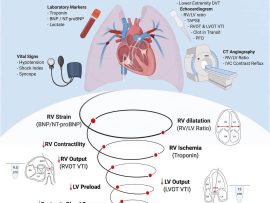Abstract Background The Society for Cardiovascular and Interventions (SCAI) classification has been shown to provide robust mortality in a variety of cardiovascular patients. Objectives This study sought to evaluate the SCAI classification in postoperative..
Read MoreAbstract Introduction Propofol infusion syndrome (PRIS) is a rare entity that could lead to profound cardiogenic shock (CS). Mitochondrial toxicity and sympathetic blockade are the mechanisms leading to CS in..
Read MoreAbstract Hemodynamic instability due to dysregulated host response is a life-threatening condition requiring vasopressors and vital organ support. Hemoadsorption with Cytosorb has proven to be effective in reducing cytokines and..
Read MoreContext Poisoning may lead to respiratory failure, shock, cardiac arrest, or death. Extracorporeal membrane oxygenation (ECMO) may be used to provide circulatory support, termed venoarterial (VA) ECMO; or respiratory support..
Read MoreAbstract Supraventricular tachycardia is the most common tachyarrhythmia in pediatrics. Although postoperative junctional ectopic tachycardia (JET) is a known complication of congenital heart surgery that is typically transient, congenital JET..
Read MoreAbstract Introduction Vasoplegia denotes a state of low tissue perfusion characterized by hypotension, tachycardia, and low systemic vascular resistance. This state results in increased mortality and morbidity following cardiac surgery...
Read MoreAbstract Purpose of review Acute pulmonary embolism (PE) is a heterogeneous disease process whose presentation varies widely between individuals who are asymptomatic, develop cardiogenic shock, or experience acute PE-related mortality...
Read MoreAbstract Background and Aim Patients presenting with type A aortic dissection (TAAD) present with a wide clinical spectrum ranging from hemodynamic stability to multiorgan malperfusion with cardiovascular collapse. Extracorporeal membrane..
Read MoreAbstract Purpose Hemorrhage is the most common cause of preventable death after trauma. Coagulopathy plays a central role in uncontrolled bleeding and is caused by multiple factors. Extracorporeal Membrane Oxygenation..
Read MoreAbstract Background To identify novel factors associated with the survival of septic adults receiving (ECMO) to improve patient selection and outcomes. Methods Cases were identified from our ECMO registry from 2001..
Read MoreAbstract Background is relatively common in the cardiac surgical patient and is usually considered a marker of illness severity. The frequency and impact of severe hyperlactatemia after elective cardiac surgery..
Read MoreAbstract OBJECTIVES Acute aortic dissection type A (AADA) is an emergency with excessive mortality if surgery is delayed. Knowledge about independent predictors of mortality on surgically treated AADA patients is..
Read MoreAbstract Objective To compare the incidence of bleeding and between adult venoarterial (VA) (ECMO) patients managed with an (ACT)-guided heparin protocol and activated (aPTT) protocol. Design . Setting Tertiary care, academic medical center...
Read MoreAbstract Background Serum lactate and central venous oxygen saturation (ScvO2) are commonly used and commonly recommended as markers of tissue oxygenation in shock states. Medical literature has both explicitly stated..
Read MoreSystemic release of cytokines and heat shock proteins in porcine models of polytrauma and hemorrhage
Abstract Objective: To define systemic release kinetics of a panel of cytokines and heat shock proteins in porcine polytrauma/hemorrhage models and to evaluate whether they could be useful as early trauma biomarkers...
Read MoreBackground Post-cardiotomy cardiogenic shock (PCCS) has an incidence of 2–6 % after routine adult cardiac surgery. 0.5–1.5 % are refractory to inotropic and intra-aortic balloon pump (IABP) support. Advanced mechanical circulatory support..
Read More












